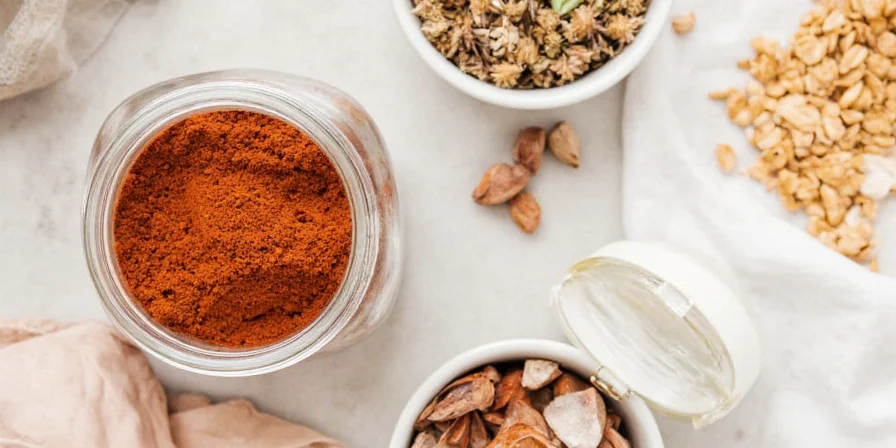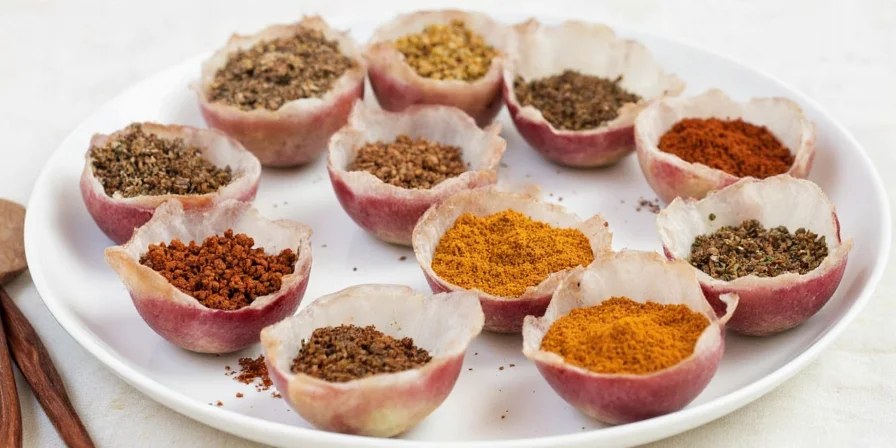Brined means soaking food (typically meat or vegetables) in a saltwater solution, often enhanced with spices, sugar, or other flavorings, to improve moisture retention, tenderness, and flavor absorption through osmotic principles. This culinary technique transforms proteins at the molecular level by altering their structure to retain more moisture during cooking while infusing deep flavors.
Unlike marinating which primarily affects surface flavor, brining penetrates throughout the food. The standard ratio is 1 cup (230g) of salt per gallon (3.8L) of water, with optional additions like sugar (½ cup), herbs, and spices. For optimal results, refrigerate the food in brine for 1 hour per pound—turkey benefits from 12-24 hours while delicate fish needs just 30-60 minutes.
Table of Contents
- What Does 'Brined' Mean? (Simple Definition)
- Brining Basics: How It Actually Works
- Wet vs Dry vs Vacuum Brining: Method Comparison
- Perfect Basic Brine Recipe (With Timing Guide)
- Spice Integration: What Works Best
- Spice Storage for Maximum Flavor Impact
- Brining Context: When to Use and When to Avoid
- 5 Proven Brining Hacks Home Cooks Need
- Global Brining Variations You Should Try
- 4 Costly Brining Mistakes to Avoid
What Does 'Brined' Mean? (Simple Definition)
Brined describes food that's been soaked in a saltwater solution (brine) to enhance moisture retention and flavor penetration. The salt in the brine breaks down muscle proteins through denaturation, creating channels that absorb and retain liquid. This prevents the "squeeze-out" effect during cooking where proteins tighten and expel moisture.

Brining vs. Marinating: Key Differences
- Brining: Salt-based solution penetrates deeply through osmosis; improves moisture retention
- Marinating: Acid-based (vinegar, citrus) primarily affects surface; tenderizes through acid breakdown
- Dry Brining: Salt applied directly to surface; draws out moisture then reabsorbs with seasoning
Brining Basics: How It Actually Works
Brining isn't magic—it's applied food science. When submerged in brine, two key processes occur:
- Osmosis: Water moves from high concentration (brine) to low concentration (meat)
- Protein Denaturation: Salt unravels protein strands, creating space to trap liquid
This dual action lets meat retain up to 25% more moisture during cooking compared to unbrined counterparts. The optimal brine concentration is 5-6% salt by weight (1 cup salt per gallon water). Higher concentrations risk oversalting; lower concentrations provide minimal benefit.

Wet vs Dry vs Vacuum Brining: Method Comparison
Choosing the right brining method depends on your time, equipment, and desired outcome. Based on culinary research from America's Test Kitchen and peer-reviewed food science studies, here's how the three primary methods compare:
| Method | Time Required | Equipment Needed | Best For | Key Advantage | Key Limitation |
|---|---|---|---|---|---|
| Wet Brining | 1-24 hours | Large non-reactive container, refrigerator space | Whole birds, large cuts of lean meat | Deep flavor penetration throughout the meat | Can dilute natural flavors; requires significant fridge space |
| Dry Brining | 12-72 hours | Salt, airtight container | Steaks, chicken pieces, roasts | Concentrated flavor with superior browning and crispy skin | Less effective for infusing complex flavors beyond salt |
| Vacuum Brining | 30-60 minutes | Vacuum sealer with liquid capability | Time-sensitive cooking, consistent results | 75% faster than wet brining with even distribution | Specialized equipment required; may alter texture if overused |
Source: Comparative analysis from Cook's Illustrated, Serious Eats, and AmazingRibs.com.
Perfect Basic Brine Recipe (With Timing Guide)
Follow this foolproof ratio for consistent results:
| Food Type | Brine Ratio | Refrigeration Time | Cooking Result |
|---|---|---|---|
| Chicken Breast | ¼ cup salt + 2 tbsp sugar per quart water | 2-4 hours | Juicy, even texture |
| Turkey (whole) | 1 cup salt + ½ cup sugar per gallon water | 12-24 hours | Moist white meat |
| Pork Chops | 3 tbsp salt + 2 tbsp sugar per quart water | 4-12 hours | Prevents drying |
| Salmon Fillet | 2 tbsp salt per quart water | 30-60 minutes | Firm texture |
Step-by-Step Brining Instructions
- Dissolve salt completely in warm water (1 cup salt per gallon)
- Cool solution to room temperature before adding food
- Submerge food completely (use weights if needed)
- Refrigerate for recommended time (never at room temperature)
- Rinse briefly and pat dry before cooking for best browning
Spice Integration: What Works Best
Spices enhance brines but require strategic addition:
- Whole Spices (peppercorns, cloves): Add directly to brine—heat dissolves compounds slowly
- Ground Spices (paprika, cumin): Mix with small amount of oil first to prevent cloudiness
- Fresh Herbs (rosemary, thyme): Add in last 30 minutes to preserve volatile oils
- Citrus Zest (lemon, orange): Adds brightness without acidity breaking down proteins

Spice Storage for Maximum Flavor Impact
Fresh spices make the difference between good and great brines. Follow these storage guidelines:
- Whole Spices: Store in airtight containers away from light (lasts 3-4 years)
- Ground Spices: Use within 6 months of opening for peak potency
- Delicate Spices (saffron, vanilla): Refrigerate in vacuum-sealed containers
- Test Freshness: Rub between fingers—if aroma is weak, replace
Brining Context: When to Use and When to Avoid
Brining isn't universally beneficial. Understanding its limitations prevents culinary mistakes. Research from the USDA and food science experts reveals specific contexts where brining excels or fails:
Best Applications
- Lean Proteins: Chicken breast, turkey, pork loin—these dry out easily during cooking (USDA Food Safety guidelines note these require moisture retention)
- Large Cuts: Whole turkeys or hams benefit from extended brining time for even penetration
- Vegetable Preservation: Cucumbers for pickles use brine for both flavor and preservation (National Center for Home Food Preservation)
When to Avoid Brining
- Fatty Meats: Duck, salmon belly, or well-marbled steaks already retain moisture; brining can make them soggy (America's Test Kitchen)
- Pre-Salted Products: Cured meats like ham or bacon become oversalted
- Crispy Skin Goals: Wet brining may inhibit skin crisping; opt for dry brining instead (Serious Eats research)
- Tough Cuts: Brisket or chuck require enzymatic tenderizing (via marinades), not salt-based brining
Source: USDA Poultry Guidelines, National Center for Home Food Preservation, and America's Test Kitchen Brining Study.
5 Proven Brining Hacks Home Cooks Need
These tested techniques deliver restaurant-quality results:
- Ice Cube Brine: Freeze herb-infused brine in ice cube trays for instant flavor bursts
- Vacuum-Assisted Brining: Cut brining time by 75% using food vacuum sealer
- Buttermilk Boost: Replace 25% of brine with buttermilk for tenderizing enzymes
- Pre-Salt Rest: After brining, let meat rest uncovered in fridge 1 hour for perfect crust
- Cold Smoke Finish: Apply light smoke after brining for complex flavor layers

Global Brining Variations You Should Try
World cuisines have perfected brining techniques:
- Scandinavian Gravlax: Sugar-cured salmon with dill (osmotic sugar draw)
- Korean Soy Brine: Soy sauce, ginger, garlic for short ribs (umami diffusion)
- Caribbean Jerk Brine: Scotch bonnet peppers, allspice berries, thyme (acidic tenderizing)
- Japanese Tataki: Vinegar-based quick brine for seared tuna (surface-only)
4 Costly Brining Mistakes to Avoid
Common errors that ruin results:
- Over-Brining: Causes spongy texture (stick to time guidelines)
- Room Temperature Brining: Risk of bacterial growth (always refrigerate)
- Reusing Brine: Contaminated with meat proteins (discard after single use)
- Skipping Rinse: For strong brines (>6% salt), rinse prevents oversalting
Frequently Asked Questions
What does 'brined' mean in cooking terms?
Brined refers to food soaked in a saltwater solution (typically 5-6% salt concentration) where osmosis and protein denaturation improve moisture retention and flavor penetration throughout the food.
How long should you brine chicken breasts?
Chicken breasts need 2-4 hours in standard brine (¼ cup salt per quart water). Over-brining beyond 4 hours causes mushy texture. Always refrigerate during brining.
Can you brine frozen meat?
No—frozen meat won't absorb brine properly. Thaw completely first. Brining frozen meat creates uneven results and potential food safety risks as the outer layers thaw faster than the center.
Why add sugar to brine?
Sugar balances saltiness and promotes better browning through caramelization. It doesn't tenderize like salt but enhances flavor complexity—use ½ the amount of sugar as salt in your brine ratio.
Do you need to cook immediately after brining?
No—after rinsing and patting dry, let meat rest uncovered in the fridge for 1-4 hours. This dries the surface for superior browning while allowing salt to fully penetrate the muscle fibers.











 浙公网安备
33010002000092号
浙公网安备
33010002000092号 浙B2-20120091-4
浙B2-20120091-4